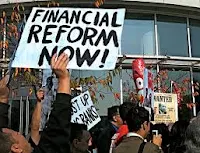It has been quite some time since Lehman Brothers—one of the
venerable investment banks from America’s Wall Street—collapsed, setting the
global financial infrastructure aflame. Now, some are wondering, of course on
hindsight, that if only the government had bailed out Lehman, markets would not
have plunged into such a mess. Some, of course, comment that the US is right in
letting Lehman fail, for capitalism squarely rests on the principle of “the
lure of wealth and the fear of bankruptcy.”
A
true analysis of the origin of the Financial Crisis – 2008 should trace a
myriad of reasons: one, low interest rates maintained by the Fed under the
leadership of Alan Greenspan for too long; two, repealing of Glass-Steagall Act
of 1933 that prevented the deposit-taking commercial banks from tying up their
capital in risky bets on securities; three, relaxation in limits on leverage
that investment banks can undertake; and, four, unbridled expansion of trading
in complex, opaque derivative transactions to even systemically important
financial institutions. Finally, it is, of course, the bonus-driven
compensation structure that made them exploit the opportunities thrown open by
the free markets to the hilt.
Above
all, there is another important reason that silently crept into the rational
decision making of investors: vanishing of equity risk premium from the US
markets. A study carried out by the Federal Reserve Bank of Minneapolis
revealed that in the last four decades preceding the collapse of Lehman,
lenders made as much return as the equity investors.
It
is this missing equity-premium that had impacted the globe badly, forcing
individual investors to look elsewhere for profits. Financial assets designed
in the Wall Street had become the main attraction for investors. The net result
was the credit bubble. And with the increased flow of dollars from the Chinese
exporters and from the petroleum-exporting countries into the Wall Street, the
credit bubble—converting even subprime mortgages into securities and selling
them to gullible investors as though they were as good as treasuries, duly
aided by dilution of standards in terms of rating, absence of prudence, and
above all an environment of lax regulations—had only inflated further to
gigantic proportions. Thanks to the Fed, as returns on these instruments got
squeezed further, even the risk-averse investors boarded the bandwagon.
As
is natural, following such unruly growth in profits for even corporates from
the Wall Street rather than from labour-linked assets, the credit bubble
finally burst, while the governments and central banks across the globe got
busy in pumping trillions of dollars—fiat money—into markets to first unfreeze
the credit markets and then to offer a safety net to the collapsing financial
architecture.
Over
and above these happenings it must also be remembered that “the array of
financiall instruments deployed within the global financial system has become
so complex that it defies understanding. For decades to come”, Dr Ken Henry
said, “policy makers around the world are going to be asking why those with sufficient
authority didn’t, at some point, stand above the buzz of the financial markets
and declare, in simple language, that all of this doesn’t make sense.”
Now,
against these happenings, what the financial markets are essentially expected
to do is: allocate scarce capital to the most productive uses, taking into
account both risk and return. In the process of allocation, markets are also
expected to pool up the incongruent information about various market participants—of
course, none of which depicts the full picture of the available investment
opportunities. And these two functions are highly interdependent.
That
said, market experiences indicate that markets do not perform these two
functions perfectly—there are limitations to aggregation of individual
motivations behind their transactions and also about the range of financial
products being offered by the markets. What it obviously means is that trading
on risks and rewards under such limitations will not give the same results that
would have been achieved from a fully informed market—a hypothetical model of
an economist. Indeed, it is this constraint on information that motivates the
varied behaviour of market participants and the varied market features. All
these imperfections would only mean: there is hardly any way to improve on
market outcomes.
It
is amidst these developments that Shann Turnbull, the author of the paper—Options for Reforming the Financial System—based
on historical experiences, has offered four non-exclusive options for reforming
the economy and the financial system: one, reintroduction of cost-carrying
money, of course in electronic form; two, allowing private issues redeemable
into official money; three, private issues convertible into specified
commodities; and four, usage of existing fiat money to reduce the cost of
seigniorage, interest on government debt, size of organizations considered too
big to fail, tax incentives to favour equity rather than debt, the different
types of risks accepted by financial institutions and the ability of banks to
create credit to finance derivatives many times greater than the GDP of the
global economy, etc. He presents a powerful argument in favour of each of these
options with a belief that the kind of present crisis can be averted by
adopting these options, although these arguments in turn pose many new
questions/problems that need to be answered more carefully.

No comments:
Post a Comment